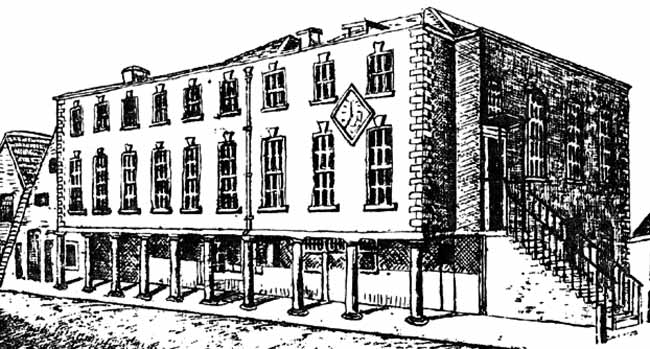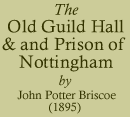II.
IN 1744, the old and picturesque front was taken out and another substituted. This was almost as devoid of archi- tectural pretentions as it is possible to conceive. The building was raised several feet higher than before, and was evidently widened. The fronts of the two upper storeys, projecting six feet over the foot-walk, were supported by ten Tuscan timber columns, forming a piazza, under which was the approach to the prisons and the jailor's house.
In his "History and Antiquities of Nottingham," published in 1840, Orange stated that the large room at the west end was then thirty-nine feet long, from north to south, and thirty-two from east to west. It was handsomely fitted up as a court of justice for the assizes and the quarterly sessions. The Town Council also assembled here. On the east side of the hall was "a large, elegant room, neatly wainscotted, called the Council Chamber, which anciently did not belong to the Hall. Here the Mayor and his brethren, before the municipal reform, used to meet and transact the business of the town; and here the Records used to be kept in a strong iron chest.' This was converted into the Grand Jury Room, and in its latest days was used as the Summons Court. This apartment was "adorned on the east side with a portrait of the celebrated Sir Thomas White; a bronze bust of Charle James Fox; a portrait of Mr. Coldham, the town clerk ; and another at the south end." It was thirty-two feet in length and eighteen in width. A small room was at the east corner, and at the south-east was the stairway to the Grand Jury gallery.
The building was now nine windows long, and these were square-headed, with a keystone by way of relief to the severity of the design. A lozenge-shaped clock dial occupied the space between the four westerly windows. The steps at the west end were turned round, and stood parallel with the front. The building was four windows in width. This erection was drawn and engraved by I. Clee, in 1750, for Deering's "Nottinghamia Vetus et Nova," published in 1751. In Glee's illustration, "the spouts that appear at the junctions of the roofs in Sandby's drawing are plainly shown projecting through the front of the restored building. The principal roof is shown with hipped ends like" the roof of the last building, which was "a plain modern king-post roof, probably erected during the alterations to the Hall, in 1791, when it assumed its uninteresting appearance." In 1789, the town jail was "razed to the ground preparatory to the erection" of the building recently demolished.

The Guild Hall in 1797.
Another engraving of this building appeared in Throsby's edition of Thoroton's, 1797. This has been kindly copied by my friend, Mr. Charles Gerring, the Nottingham representative of the publisher of this pamphlet, who has added to his kindness by defraying the cost of a process-block, of which we give an impression. By comparing the illustrations in Deering's and Throsby's Thoroton, it will be seen that there was no external change in the building and that adjoining during the intervening half century, except the fixing of a spout which emptied itself above the heads of passers-by on the causeway; but the adjacent building made way for a larger one by the time Blackner issued his history.
In 1773, Howard visited Nottingham while on his tour of inspection of the prisons of England. In his work on the subject he wrote:—"County Goal at Nottingham, in 1775—Gaoler, Richard Bonington; salary, £20; fees, debtors, felons, 14s. 8d.; transports, £7 17s. 6d. each; licence, beer. Prisoners'allowance —Debtors,three halfpennyworth of bread a day: felons, three halfpennyworth of bread and halfpenny in money every day (weight of threepenny loaf in January, 1775, 1lb. 14½ounces); garnish prohibited. Chaplain, Rev. Mr. Anderson; duty, Sunday and Wednesday; salary, £50. Surgeon, Mr. Betteson, now Mr. Partridge; salary, £20, now £30, for debtors and felons. The gaol is on the side of a hill. For master's side debtors only three rooms. Down 28 steps are three rooms for criminals who can pay. Down 12 steps more are deep dungeons, cut in the sandy rock, very damp, one of which is 23ft. by 13ft., and 7ft. high. Another, nearly circular, is about 12ft. diameter. The straw on barrack beds. At my last visit the felons' court was more airy, the wall being palisaded, and there was an entire separation of debtors and felons. For bathing, here is (not, as in most other county goals, an inconvenient and almost useless tub —but) a large and very commodious bath, supplied with river water, and a copper just by to warm it when necessary. This bath is a late improvement; and so is the infirmary, near it, which has two rooms. The Act for preserving the health of prisoners is neatly painted over the keeper's door. The justices have allowed the gaoler to supply the sick with better nourishment, &c., to the amount of 7s. a week. Gentlemen so remarkably considerate and humane will, I hope, abolish the unwholesome dungeons. Nottingham Town and County Gaol—Gaoler, Richard Bonington, the county gaoler; salary, £8; fees, debtors, 8s. if under £10, 14s. 8d. if from any court in London; felons, 14s. 8d.; transports, £7 17s. 6d. each: licence, see County Gaol. Prisoners' allowance—Debtors, none; felons, 1½d. in bread a day; garnish, lately prohibited; chaplain, none; surgeon, none stated—the Mayor orders one when wanted. This gaol has been lately repaired and much improved. Three rooms on the ground floor, two chambers, and two garrets. A dungeon, down 22 steps, which I was informed has not been used for some years. A back court well supplied with water. Debtors have, from a legacy, 1s. a week for coals. Collected in the town, for prisoners, about £4 or £5 a year. A table of fees was hung up, dated the 10th of April, 1777, signed by Tho. Sands (Mayor), Rich. Butler and John Fellows (Aldermen), and confirmed by W. H. Ashurst, similar to that in the county gaol."
W. Hepworth Dixon, in his book on Howard, says that the state of affairs were much the same in Leicester and Nottingham:—"The gaol was built upon the declivity of a hill; down about five-and-twenty steps were three rooms for such as could pay for them. The poorer and honest prisoners were compelled to descend twelve steps more, into a series of cells cut in the solid rock for their reception—only one of which was in use at the time—a cavern twenty-one feet long, thirty feet broad, and seven high. In this horrible hole they were sometimes immured for years."
At this time torturing prisoners here had not been abolished, but it was during the same year—when two cattle stealers were, on April 13th, 1773, sentenced by Blackstone to be imprisoned and to be branded in open court. In front of the prisoners' dock was a frame. Into this the offender who was sentenced to branding placed his hand. This was secured by a screw. When in that position a red hot marking iron was pressed upon the fleshly part of the thumb—and thus an indelible and disgracing mark was made.
The front, depicted as it was at the close of last century, and shown by us on page 8, was altered, in 1791, to suit the requirements of a police court, and this part of the building made into one of two storeys instead of three, and the three pairs of westerly windows were made into single windows, with the cills raised, so as to allow room for the public windows to present a little better appearance than immediately before the alteration. The Guild Hall as it appeared about 1815 is depicted in Blackner's ''History of Nottingham." At a subsequent period the fourth and fifth windows, counting from the approach, were made into one, the windows being long and semi-circular headed. A new clock and circular dial displaced the former lozenged-shaped dialled clock in 1808. Later on, the front was plastered over and painted.
The bell, now in Sir John Turney's possession, was "suspended by a strong iron frame, surmounted by a vane, &c., rising to a considerable height above the roof," to which it was fastened. This struck the hour. It bears this inscription: "Thomas Mears and Son, London, friget 1807," and originally weighed 2cwt. 3qrs. 12lbs. It has "a very fine mellifluous sound," and was heard at a considerable distance. The bell-hammer was twenty-eight pounds in weight
The room under the hall was used as a guard-house by the military. This was converted into a kitchen for the gaoler in 1805. The governor's apartments were reached by a door on the right hand of the entrance from the street. This had communication with all parts of the prison, and "also, by means of a step-ladder through a trap door, to the dock of the Assize Hall." The lobby was reached "through a strong wooden door, defended by large iron nails, and secured with strong locks and bars." Under this lobby was an ample supply of Trent water. The left hand of this lobby was open to the debtor's yard and the passage leading to their cells, from which it was divided by strong iron bars, reaching from floor to ceiling, ten feet in height. Here was an iron gate, and a little further on was another, which led to the yard of the felons and female debtors. Felons were allowed to see their friends through the bars of the two gates, which were five feet apart.
In the turnkeys' lodge, "five paces by four," at the south end of the lobby, were displayed "a frightful array of handcuffs, chains, and irons, of various gradations of weight, for the ancles, legs, waist, neck, arms, and hands, hung up on the wall at the south end of the room," which they completely covered. On the east side of this small room were hung up the instruments of death—a label, bearing the name of the person who was hung by it, and the nature of his crime.
Among the jailors of local note were Philip Bailey and George Vason. The first-named was the father of Thomas Bailey, the author of "Annals of Nottinghamshire," and grandfather of Philip James Bailey, author of "Festus." At the time of his appointment to the position named he was engaged in the hosiery trade. Wylie tells us that "when Daniel Coke's obnoxious Bill was passed, empowering the county magistrates to act in and for the town, a strong party spirit prevailed; and the justices of the shire, in the exercise of their newly-acquired power, deposed George Vason from the governorship of the Union Workhouse. Hereupon Philip Bailey voluntarily resigned the situation of governor of the town jail for the purpose of allowing the town magistrates to confer the vacant office upon Vason. Mr. Bailey was held in high estimation; and it is related that, during the twenty years in which he discharged the duties of jailor, so honourably vigilant were his habits that there was not a single instance of a prisoner having made his escape." After retiring from his duties he did not receive a permanent annuity, as popularly believed. Vason was appointed in 1820. In early life he went out as an artisan with a missionary party to the islands of the Southern Seas. He held his position until his death, on July 23, 1838, at the age of sixty-six, and was interred in the Baptist burial ground in Mount Street. Mr. Robert Lineker was a successor.
In 1846, the borough gaol was merged into the House of Correction in St. John's Street.
